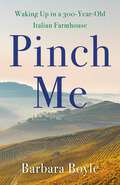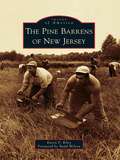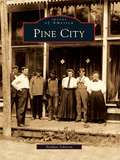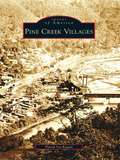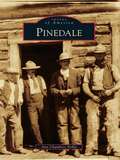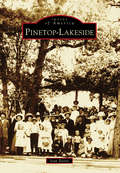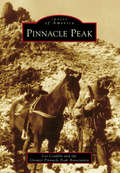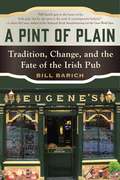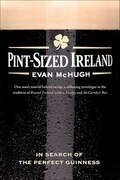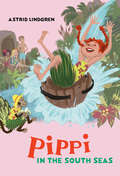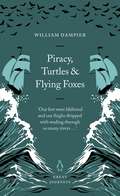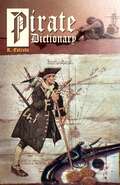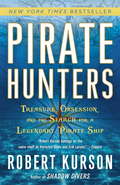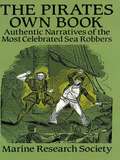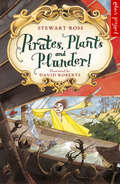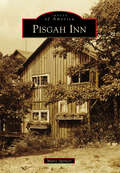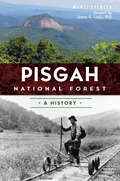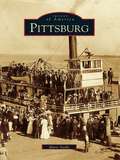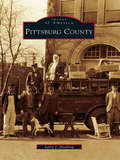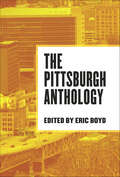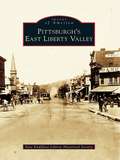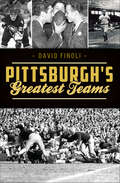- Table View
- List View
Pinch Me: Waking Up in a 300-Year-Old Italian Farmhouse
by Barbara BoyleFor fans of Stanley Tucci and Frances Mayes, Barbara Boyle&’s story of leaving her California home to restore an old stone farmhouse in Italy&’s Piedmont—only to fall in love with the food and people of her enchanting new town—will delight and inspire. An updated twist on the classic Under the Tuscan Sun, this is the deeply personal story of how fiftysomething Barbara Boyle leaves her busy and familiar life behind in San Francisco and begins taking apart a 300-year-old stone barn to build a new home—a new life—in the largely undiscovered region of Piedmont, Italy. Filled with discoveries and pleasures of the stunning places and food she encounters, Pinch Me also details Barbara&’s frustrations in adjusting to a new culture, as well as the startling heartbreak of being faced with a breast cancer diagnosis. But even in the midst of this crisis, she and her husband create a home out of the stone ruin they had found, forming deep friendships in their little town and unlocking a new level of joy in life. She shares intimate moments, joyous and bittersweet, as a new wife, stepmom, and a member of a community—and, of course, she shares a few recipes reflecting the gastronomical excellence of the region. A touching memoir filled with food, friendships, and scenes of Italy, Pinch Me is ultimately a celebration of love, of learning to see the world, as well as oneself, through a different window, and of the powerful joy that comes from building a dream.
Pine Barrens of New Jersey, The
by Budd Wilson Karen F. RileyThe Pine Barrens of New Jersey cover 22 percent of the most densely populated state in the country. It is the largest stretch of open space between Boston, Massachusetts, and Richmond, Virginia. It reaches across 56 municipalities and 7 counties. The name came from early settlers who thought the area was a vast wasteland, but it is anything but barren. Underneath this incredible natural resource lies almost 17 trillion gallons of some of the purest water on earth. Stands of pitch pine gave birth to the charcoal industry, and its acidic swamps were used first for bog iron and later for cranberry production. Many firsts came from this area, including cranberry sauce, cultivated blueberries, and grape juice. Numerous industries have risen and fallen over time. Remnants of forgotten ghost towns bear witness to that history, but the real stories come from the people who lived and worked there.
Pine City
by Nathan JohnsonLaden with pines and interspersed with lakes and rivers, Pine City has long served as the gateway to Minnesota's Northwoods. Over the years, people have traveled through the area via the river, military road, railroads, and scenic highway. In the 1880s, as people of European decent were settling in, the crux of the community moved from Chengwatana, Ojibwe for "City of Pines," to a location west of there, nearer the rail line, called Pine City. The story begins with the fur trade and takes one through a fascinating journey of the logging industry, showing the rural community's transition from predominantly agricultural underpinnings to a more diversified economy. This collection of vintage photographs highlights Pine City's laboring people and other influences that have had roles in shaping what it is today-a city of great history, unique people, nostalgic small-town traditions, and mystifying legends.
Pine Creek Villages (Images of America)
by David Ira KaganPioneer settlers began arriving in Pine Creek Valley after the Revolutionary War, drawn to the pristine wilderness filled with towering white pines and hemlocks. In the 1880s, descendants of those settlers began extensive lumbering operations aided greatly by the arrival of the railroad through the valley. Additional logging railroads were rapidly constructed up the tributary runs to the great stands of trees. Pine Creek's villages flourished, with both large and small sawmills buzzing. Around 1910, when the great lumbering days ended, many of the village populations plummeted. Throughout the 20th century and into today, the area remains a popular tourist destination for fishing, hunting, and outdoor enthusiasts.
Pinedale
by Ann Chambers NobleJohn F. Patterson founded Pinedale in 1904 after proposing the establishment of a town along Pine Creek in western Wyoming. Patterson offered to build and stock a general store if local ranchers Charles Petersen and Robert Graham would donate five acres each for the site. Petersen and Graham agreed to this plan, a surveyor was hired, and Pinedale--named after the post office on Petersen's ranch--was officially established. Free town lots were offered to early settlers, and Pinedale was incorporated in 1912, becoming the farthest incorporated town from a railroad, and later from a major highway, in the country. The community survived in fierce isolation, and the townspeople originally made their living supplying the ranchers, outfitters, and tie hacks. Ranching and tourism helped sustain Pinedale from the beginning, and in the 1990s, the community underwent a fundamental change with the introduction of natural-gas mining in the area. Pinedale residents continue to live and thrive on this harsh but beautiful land.
Pinetop-Lakeside
by Joan BaezaIn 1984, the White Mountain communities of Pinetop and Lakeside in east-central Arizona undertook a "marriage of convenience" and incorporated. Historically, they could not be more different. Like rival sisters, one was pious and churchgoing while the other was wayward and fun loving. But in the best of American traditions, they formed a town government to provide services for their combined residents. Pinetop-Lakeside's history is as rough-and-tumble as that of any Western town. Settlement began with the establishment of Fort Apache in 1871. The cavalry post provided employment for freighters and skilled laborers, as well as a market for beef, hay, and grain. The 1880s brought colonists from the Church of Jesus Christ of Latter-day Saints. They built the dams and lakes that in the next century would become the basis for an economy based on outdoor recreational tourism. Today, Pinetop-Lakeside is a thriving community of approximately 4,500 residents. One thing that hasn't changed since the time of the pioneers is the natural beauty that defines life on the mountain.
Pink Tourism: Holidays of Gay Men and Lesbians
by Howard L. HughesThis book presents a detailed picture of gay and lesbian tourism from, primarily, a marketing perspective and examines how marketing activity engages with and affects social issues relating to homosexuality. It gives an overview of the nature of homosexuality and relevant issues that bear upon tourism and marketing.
Pinkalicious: Lost In Paris (I Can Read Level 1)
by Victoria KannYoung readers will be swept up in Pinkalicious’s pinkatastic Parisian adventure in this Level One I Can Read!Pinkalicious gets distracted and loses track of Mommy, Daddy, and Peter on a family trip to Paris. But fortunately, Pinkalicious remembers Mommy's advice and knows what to do!Pinkalicious: Lost in Paris is a Level One I Can Read, which means it’s perfect for children learning to sound out words and sentences. Whether shared at home or in a classroom, the short sentences, familiar words, and simple concepts of Level One books support success for children eager to start reading on their own.Readers can watch Pinkalicious and Peter on the funtastic PBS Kids TV series Pinkalicious & Peterrific!
Pinnacle Peak
by Greater Pinnacle Peak Association Les ConklinPinnacle Peak is north Scottsdale's most prominent landmark, rising out of the desert floor to an elevation of 3,170 feet. For years, Pinnacle Peak was Scottsdale's "secret" destination for hiking, rock climbing, and horseback riding. In 1985, with urban sprawl surging northward, Scottsdale's city council acted to preserve Pinnacle Peak as a municipal park. Pinnacle Peak visitors are impressed by the sweeping vistas, the rugged beauty of the Sonoran Desert, the manicured golf courses, and the unique wildlife. Few people realize that the surrounding landscape covers the forgotten footprints of prehistoric hunter-gatherers, Hohokam, Yavapai, the US Cavalry miners, homesteaders, ranchers, developers, and colorful characters of the past. Spanning 150 acres, Pinnacle Peak Park has become one of the most popular attractions in the Phoenix metropolitan area, and its scenic beauty is enjoyed by people from all over the world.
A Pint of Plain: Tradition, Change, and the Fate of the Irish Pub
by Bill BarichAfter meeting an Irishwoman in London and moving to Dublin, Bill Barich?a “blow-in,” or stranger, in Irish parlance?found himself looking for a traditional Irish pub to be his local. There are nearly 12,000 pubs in Ireland, so he appeared to have plenty of choices. He wanted a pub like the one in John Ford's classic movie, The Quiet Man, offering talk and drink with no distractions, but such pubs are now scare as publicans increasingly rely on flat-screen televisions, rock music, even Texas Hold ‘Em to attract a dwindling clientele. For Barich, this signaled that something deeper was at play?an erosion of the essence of Ireland, perhaps without the Irish even being aware. A Pint of Plain is Barich's witty, deeply observant portrait of an Ireland vanishing before our eyes. While 85 percent of the Irish still stop by a pub at least once a month, strict drunk-driving laws have helped to kill business in rural areas. Even traditional Irish music, whose rich roots “connect the past to the present and close a circle,” is much less prominent in pub life. Ironically, while Irish pubs in the countryside are closing at the alarming rate of one per day, plastic IPC-type pubs are being born in foreign countries at the exact same rate. From the famed watering holes of Dublin to tiny village pubs, Barich introduces a colorful array of characters, and, ever pursuing craic, the ineffable Irish word for a good time, engages in an unvarnished yet affectionate discussion about what it means to be Irish today.
Pint-Sized Ireland: In Search of the Perfect Guinness
by Evan McHughOne man's tour of Ireland on tap; a rollicking travelogue in the tradition of Round Ireland with a Fridge and McCarthy's Bar."Regret" is the word that best describes Evan McHugh's first taste of Guinness. For an Australian raised on Vegemite, Ireland's black brew is very much an acquired taste. But the travel-writer is committed to acquiring it. Determined to discover exactly what makes a pint of Guinness so legendary, he crosses the Emerald Isle in search of his answers.But in sampling pints as he goes, McHugh soon realizes that in each town, and at every pub, someone always says that the best glass of Guinness is to be found . . . . somewhere else. In his comedic and sentimental journey, McHugh and his companion, Twidkiwodm (the-woman-he-didn't-know-he-would-one-day-marry), hitch around Ireland, meeting unforgettable characters. He goes rowing with a German bagpiper on the lakes of Killarney, windsurfing with a one-armed man in Dingle, survives an encounter with poteen and even finds his own bar . . . but keeps searching for the perfect pint.As entertaining as it is informative, Pint-Sized Ireland is both a hilarious travelogue and thoughtful diary. McHugh's comedic voice swiftly moves in and out of pubs, peering into froth-rimmed pints, and leading readers to question: So does he ever find the perfect pot of black gold? Those who have rested upon the barstools of Ireland, who have sought the famed "perfect pint of Guinness," realize that perfection rests in more than just the taste. McHugh captures the visceral experience of Guinness and Ireland in a warm memoir that's perfect to savor.International Praise for Pint-Sized Ireland"McHugh's idea of traveling is one continuous pub crawl . . . an entertaining homage to the black brew."---The Age (Australia)"McHugh's writing style is intelligent, quirky, and conversational. The result is a consummately easy to read book, amusing and engaging. It'll make you want to go in search of your own perfect pint."---Adventure Travel"This is a lovely book, well written, full of humorous anecdotes and works both as a travelogue and as a guide to drinking in Ireland. One of the real joys of this book is the way that the author captures the nuances and syntax of the way the people speak (‘"Rooit", said the pub-landlord, ‘in ye coom"'). After a few pages you find yourself falling into this yourself and by the time you finish the book you will have developed a full-blown Irish accent."---www.bootsnall.com
Pippi in the South Seas (Pippi Longstocking)
by Astrid LindgrenWhen Pippi&’s father, the king, sends for her, she decides to take her best friends Tommy and Annika with her to Kurrekurredutt Island. The island is fantastic and Pippi has one crazy adventure after another! Pippi is even made a princess---Princess Pippilotta. But will Pippi and her friends really want to live on the island forever, never to return to Villa Villekulla? "Any reappearance of the irrepressible Pippi Longstocking is cause for celebration. This installment is no exception." -The New York Times
Piracy, Turtles and Flying Foxes (Great Journeys Ser.)
by William DampierDampier's (1651-1715) adventures and writing inspired both Robinson Crusoe and Gulliver's Travels, but in his own right he was a remarkable, observant and enjoyable writer - whether on a woefully mishandled pirate raid in Spanish America or on a desperate journey to Sumatra in an open boat or on the habits of manatees or bats. He also left the first description in English of the Aborigines of Australia - thus initiating a painful, now three centuries' long encounter between peoples on opposite sides of the world.Great Journeys allows readers to travel both around the planet and back through the centuries – but also back into ideas and worlds frightening, ruthless and cruel in different ways from our own. Few reading experiences can begin to match that of engaging with writers who saw astounding things: Great civilisations, walls of ice, violent and implacable jungles, deserts and mountains, multitudes of birds and flowers new to science. Reading these books is to see the world afresh, to rediscover a time when many cultures were quite strange to each other, where legends and stories were treated as facts and in which so much was still to be discovered.
Pirate Dictionary
by Rafael EstradaCompilation of famous pirates and nautical terms. Did you know that Bartolomew Roberts was a distinguished, elegant and courteous pirate, music lover, teetotaler and that he did not allow gambling with money or duels on board...? That when Blackbeard went to combat, he placed hemp wicks soaked in saltpeter, lit under his fur hat, in order to appear surrounded by black smoke and cause terror...? Do you know the difference between a pirate, a buccaneer, a privateer and a filibuster...? Would you distinguish a cutlass from a saber...? This book contains all the documentation that I used to write the novel THE CIRCULAR PIRATES. Sorted in dictionary format for easy searching, it is an excellent source for authors who wish to embark on the wonderful adventure of writing a pirate story.
Pirate Hunters
by Robert KursonA thrilling new adventure of danger and deep-sea diving, historic mystery and suspense, by the author of the New York Times bestseller Shadow Divers Finding and identifying a pirate ship is the hardest thing to do under the sea. But two men--John Chatterton and John Mattera--are willing to risk everything to find the Golden Fleece, the ship of the infamous pirate Joseph Bannister. At large during the Golden Age of Piracy in the seventeenth century, Bannister should have been immortalized in the lore of the sea--his exploits more notorious than Blackbeard's, more daring than Kidd's. But his story, and his ship, have been lost to time. If Chatterton and Mattera succeed, they will make history--it will be just the second time ever that a pirate ship has been discovered and positively identified. Soon, however, they realize that cutting-edge technology and a willingness to lose everything aren't enough to track down Bannister's ship. They must travel the globe in search of historic documents and accounts of the great pirate's exploits, face down dangerous rivals, battle the tides of nations and governments and experts. But it's only when they learn to think and act like pirates--like Bannister--that they become able to go where no pirate hunters have gone before. Fast-paced and filled with suspense, fascinating characters, history, and adventure, Pirate Hunters is an unputdownable story that goes deep to discover truths and souls long believed lost.Advance praise for Pirate Hunters "A great thriller full of tough guys and long odds . . . and: It's all true."--Lee Child "Action and adventure on land and sea--you can't ask for more. But Robert Kurson raises the ante in Pirate Hunters with an array of mystery and a fleet of colorful characters spanning four centuries. This is a great summer read!"--Michael Connelly "Pirate Hunters is a fantastic book, an utterly engrossing and satisfying read. It tells the story of the hunt for the rare wreck of a pirate ship, which had been captained by one of the most remarkable pirates in history. This is a real-life Treasure Island, complete with swashbuckling, half-crazy treasure hunters and vivid Caribbean settings--a story for the ages."--Douglas Preston "A terrific read. I was pulled in from page one. Kurson brings us face to face with some of the most swashbuckling pirates ever to sail the Caribbean, even as he takes us underwater on a high-tech quest to discover the relics they left behind."--Daniel James Brown "There's nothing in the world like buried treasure--and people hungry and obsessed enough to risk their lives for it. Pirate Hunters isn't just a good story--it's a true one. Searching for the souls of its explorers, it takes you to the far tip of the plank and plunges you deep to the bottom of the ocean."--Brad Meltzer "Pirate Hunters is a gripping account of two courageous divers' quest to uncover the shipwrecked vessel of Joseph Bannister, one of history's most infamous pirates. Robert Kurson will keep you on the edge of your seat in this high-stakes journey around the globe that ultimately teaches these explorers about much more than an old ship."--Sen. John McCain "Kurson's own enthusiasm, combined with his copious research and an eye for detail, makes for one of the most mind-blowing pirate stories of recent memory."--Publishers Weekly (starred review)From the Hardcover edition.
The Pirates Own Book: Authentic Narratives of the Most Celebrated Sea Robbers (Dover Maritime Series)
by Marine Research SocietyIn these delightfully melodramatic accounts, originally published in an extremely rare 1837 volume, you'll find true stories of the diabolical desperadoes who plundered ships on the high seas and murdered their passengers and crews. The stories — based on contemporary newspaper accounts, trial proceedings, and Admiralty records — describe in lurid detail the life, atrocities, and bloody death of the infamous Black Beard as well as the cold-blooded exploits of Jean Lafitte, Robert Kidd, Edward Low, Thomas White, Anne Bonney, Mary Read, and scores of other maritime marauders.The first edition of The Pirates Own Book was published in Boston, Massachusetts, in 1837, and during the next 25 years it was followed by at least eight other editions. Today it is a rarity among collectors. Now available once again in this inexpensive edition, it will thrill lovers of drama on the high seas or any reader interested in the true-life adventures of the ruthless men and women who sailed under the black flag so long ago.
Pirates, Plants And Plunder!
by Stewart RossTwelve fascinating tales about the adventurers who travelled all over the globe, finding new plants and the amazing things they produce. Join Joseph Banks as he gets stranded on the Australian Great Barrier Reef whilst searching for new botanical specimens. Battle with the Mexican Emperor Montezuma against the invading Hernando Cortes - and watch as Cortes introduces chocolate to the rest of the world! Struggle with other travellers as they fight starvation, bears, strange diseases and tropical storms.Exciting, witty and wacky, these true-life tales span centuries and the globe, feature famous historical figures such as Captain Bligh, Darwin and Columbus and put the origins of 'everyday' plants into perspective.
Pisgah Inn (Images of America)
by Marci SpencerAround 1919, George Weston left New York to return to his boyhood home in the Arden-Fletcher area of Western North Carolina. The US government had recently established Pisgah National Forest by purchasing 80,000 acres from Edith, George Vanderbilt's widow; lands deserted by logging companies; and other tracts. While superintendent of farms at the Biltmore Estate, Weston had admired those mountainous landscapes. About two miles from Mount Pisgah and a mile from Vanderbilt's private Buck Spring Lodge, Weston constructed Pisgah Inn on property leased from the US Forest Service. Visitors came from across the country and around the world to stay and dine at Pisgah Inn. By the 1940s, the construction of the Blue Ridge Parkway brought drastic changes across the narrow, isolated Pisgah ridgeline. Today, a more modern 1960s lodge welcomes guests to its grand views and preserves the history, charm, and natural setting of the original Pisgah Inn.
Pisgah National Forest: A History (Natural History)
by Marci Spencer James G. LewisWhen George Vanderbilt constructed the Biltmore House, he hired forester Gifford Pinchot and, later, Dr. Carl A. Schenck to manage his forests. Over 80,000 of his woodland acres became the home of America's first forestry school and the heart of the East's first national forest formed under the Weeks Act. Now comprising more than 500,000 acres, Pisgah National Forest holds a vast history and breathtaking natural scenery. The forest sits in the heart of the southern Appalachians and includes Linville Gorge, Catawba Falls, Wilson Creek Wild and Scenic River, Roan Mountain, Max Patch, Shining Rock Wilderness and Mount Pisgah. Author and naturalist Marci Spencer treks through the human, political and natural history that has formed Pisgah National Forest.
Pittsburg
by Marti AielloSituated at the far reaches of the Bay Area, Pittsburg has long been perceived as a commuter town, an out-of-the-way bedroom community. Yet this city has a rich and varied history stretching back to the early days of statehood and has played an important role in commerce, both to the state and to the Bay Area. Before long the burgeoning city had a fishing industry rivaling that of San Francisco's famed Fisherman's Wharf and a largely Italian fishing community. By the 1900s, a surprising number of industries set up factories along the waterfront property of Pittsburg. In 1942, the beginning of World War II brought the building of Camp Stoneman, an important departure point for many servicemen. Later, the city became known as a residential destination. Readers of this book will surely see Pittsburg in a new light as they enjoy the surprising and varied tales of the city's previous generations.
Pittsburg County
by Larry J. HoeflingNorth of the thick pine and oak forests of the Ouachitas Mountains, in the foothills beyond the Kiamichi and the Winding Stair Mountains, two trails crossed in the rolling valley nestled between the Shawnee Hills and the Sans Bois Mountains. In the early 1800s, that valley became the home of the Mississippi Choctaw tribe, part of the U.S.-designated Indian Territory. When the railroad boom of the late 1800s occurred, the tracks followed the same cattle trails and pioneer roads, creating a transportation hub at the point where rail lines intersected, a place that later became the county seat of Pittsburg County.
The Pittsburgh Anthology (Belt City Anthologies)
by Eric Boyd&“Characterizing a place can be an elusive project, but The Pittsburgh Anthology is . . . diverse, surprising, eloquent, playful, scrappy, and tenacious.&” —Ploughshares Pittsburgh is ever-changing—once dusted with soot from the mills, parts of the city now gleam with the polish of new technologies and little remains of what had been there before. The essays and artwork in this anthology aim for the surprising, elusive stories that capture a Pittsburgh that is in transition. Contributors run the gamut from MacArthur-award winning photographer, LaToya Ruby Frazier to 15-year-old Nico Chiodi, the book&’s youngest contributor who chronicles the doings of the North Side Banjo Club. &“Everyone in this book,&” writes editor, Eric Boyd, &“is talking about the city, the things surrounding it; all of the pieces have been created with experience, intimacy, and personality. This book, I hope, will speak to you, not at you. Because we all know this city is changing. We&’re just not exactly sure what that means.&” Included are contributions by Amy Jo Burns, LaToya Ruby Frazier, Ben Gwin, Cody McDevitt, David Newman, and many more. &“These voices are varied and quirky, some polished and professional sounding, some a little rough around the edges. But they are uniformly interesting and genuine.&” —Pittsburgh Post-Gazette &“What editor Eric Boyd has chosen to do is temper all of the Most Livable City rah rah with essays, stories and poems of a grittier, more complex nature.&” —Pittsburgh Magazine &“This collection is stimulating for insiders and outsiders alike, a portrait Boyd has designed to be from-the-streets, warts-and-all.&” —Bill O&’Driscoll, PGH City Paper
The Pittsburgh Pirates Encyclopedia: Second Edition
by David Finoli Bill RanierThe Pittsburgh Pirates have one of the most storied histories in the annuals of baseball. The Pittsburgh Pirates Encyclopedia captures these fabulous times through the stories of the individuals and the collective teams that have thrilled the Steel City for 125 years. The book breaks down the team with a year-by-year synopsis of the club, biographies of over 180 of the most memorable Pirates through the ages as well as a look at each manager, owner, general manager and announcer that has served the club proudly.<P><P> Now updated through the 2014 season, The Pittsburgh Pirates Encyclopedia will provide Pirates fans as well as baseball fans in general a complete look into the team's history, sparking memories of glories past and hopes for the future. Highlights include:<P> * Single-season and career records<P> * Player and manager profiles<P> * Pirates award winners<P> * Synopses of key games in Pirates history<P> Now fully updated, this is one of the most comprehensive books ever written about the Pirates, and a resource that no Bucs fan should be without.
Pittsburgh's East Liberty Valley
by East End/East Liberty Historical SocietyPittsburgh's East Liberty Valley originally consisted of lush hunting grounds used by many Native American groups. In the 1700s, British general John Forbes instructed George Washington to build a military road from Fort Ligonier through the East Liberty Valley to the forks of the Ohio River. In 1758, Forbes traveled this widened trail, first named for him, now known as Penn Avenue. Many plantations were established after the Revolution, and the village grew, with its tollhouse and taverns serving stagecoaches and Conestoga wagons en route to Pittsburgh. By the 20th century, East Liberty was one of the wealthiest suburbs in America. Many famous firsts occurred here, including the building of the nation's first gasoline service station and the founding of the National Negro Opera Company. The area also boasts many famous residents, including Billy Eckstine, Erroll Garner, Gene Kelly, Dick Powell, and Lillian Russell. Through vintage photographs, Pittsburgh's East Liberty Valley salutes the area's rich history.
Pittsburgh’s Greatest Teams (Sports)
by David FinoliPittsburgh is synonymous with winning. From the Penguins and Steelers to the Pirates and Panthers, the Steel City knows championships.There must be something special in the water to make Pittsburgh so particularly gifted with its sports teams. The most famous teams in the city's history would most likely be the 1970s Steelers, known as the Steel Curtain for obvious reasons, and the Penguins who raised the Stanley Cup five times. Names such as Lemieux, Crosby, Roethlisberger, Bradshaw, Clemente and Stargell are legends of American sport and members of Pittsburgh's most cherished franchises, but for every sports legend and multi-million dollar franchise, there are a dozen more talented players and long-past teams that have been forgotten to history; the Negro League's Crawford and Homestead Grays are too often overlooked in the city's sports history but were as talented as any team that has played there. Author Dave Finoli ranks the fifty greatest teams that won trophies, brought glory and lifted the hearts of Pittsburgh's devoted sports fans.
